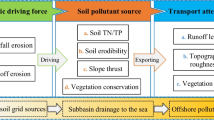Abstract
Under the condition of different precipitation intensities, different gradients, different land-use types and different vegetation coverage, the soil erosion and transference of element (or pollutant) are studied by simulating and analyzing the surface run-off of experimental plots in the catchment area of Songhua Lake, with an area of about 43 370.8km2. And the influencing factors that produce the spatial difference are analyzed and assessed. It is put forward that the irrational land utilization is the reason of soil erosion and pollutant run-off. The gradient of farmland, the growing season of vegetation and the vegetation coverage are chiefly restricting factors that lead to the soil erosion and pollutant run-off. This study can provide the fundamental data for comprehensive planning and harnessing of the non-point source pollution in the valley.
Similar content being viewed by others
References
HOU Yu-guang, 1987. The non-point water pollution of strong rain [J]. Water Resources Protection, (4):49–58 (in Chinese)
JACKSON W A, ASMUSSEN R J, ELLIS D F, 1973. Nitrate in surface and subsurface flow from a small agricultural watershed [J]. J. Environ. Qual., 2: 480–482.
LAL R, 1990. Research and development priorities in soil degradation [J]. Advances in Soil Science, (2): 331–336.
SUN Hui, TANG Ya, CHEN Ke-ming et al., 1999, The influence of nitrogen fixation plants on sloping-plowland erosion [J]. Bulletin of Soil and Water Conservation, 19(6):1–4. (in Chinese)
WANG Ning, ZHU Yan-ming, LI Shun, 1999. The dynamic change and formation analysis of elements in Songhua Lake [J]. Research of Environmental Sciences, 12(5):27–30. (in Chinese)
WANG Ning, ZHU Yan-ming, XU Chong-gang, 2002, The quantity study of rainfall pollutant in valley by GIS [J]. Journal of Northeast Normal University, 34(2): 92–98. (in Chinese)
YANG Zhi-sheng, 1999. The study on soil erosion equation of sloping-plowland in Northeast Yunnan Province [J]. Bulletin of Soil and Water Conservation, 19(1):1–9,(in Chinese)
YONG R A, ONSTAD C A, ANDERSON W P, 1989. AGNPS:A nonpoint-source pollution model for evaluating agricultural watersheds [J]. J. of Soil and Water Conservation, 44(2):168–173.
ZHANG Da-di, ZHANG Xiao-hong, DAI Yu-min, 1997. The investment and assessment of the four surface runoff pollutants in Shanghai suburb [J]. Shanghai Environmental Sciences. 16(9):7–11.(in Chinese)
ZHANG Xing-chang, LIU Guo-bin, FU Hui-fang, 2000. The influence of different vegetation coverage on N element runoff in valley [J]. Environmental Science, 21(6):16–19.(in Chinese)
Author information
Authors and Affiliations
Additional information
Foundation item: Under the auspices of Chinese Academy of Sciences (KZ952-S1-201)
Biography: WANG Ning (1953–), female, a native of Beijing, associate professor, Ph. D., specialized in environment geography and the control and management of water pollution
Rights and permissions
About this article
Cite this article
Wang, N., Zhu, Ym. & Wang, Hl. Quantitative study of soil erosion and element run-off in the Songhua Lake valley. Chin. Geograph.Sc. 13, 238–241 (2003). https://doi.org/10.1007/s11769-003-0023-6
Received:
Issue Date:
DOI: https://doi.org/10.1007/s11769-003-0023-6




